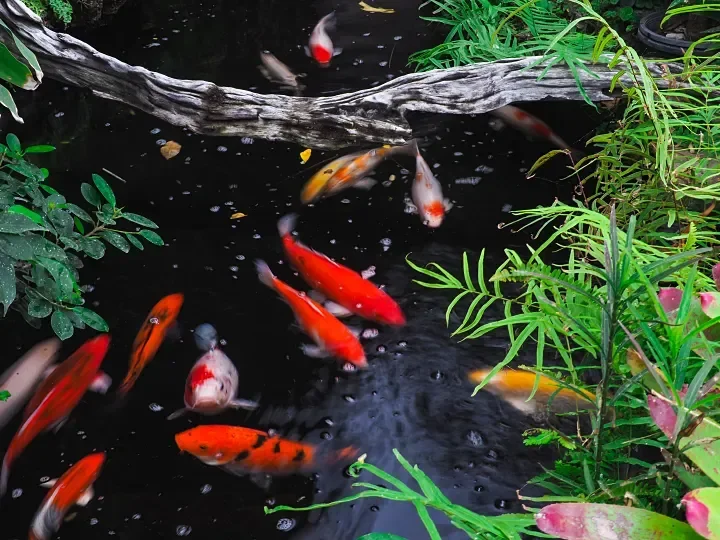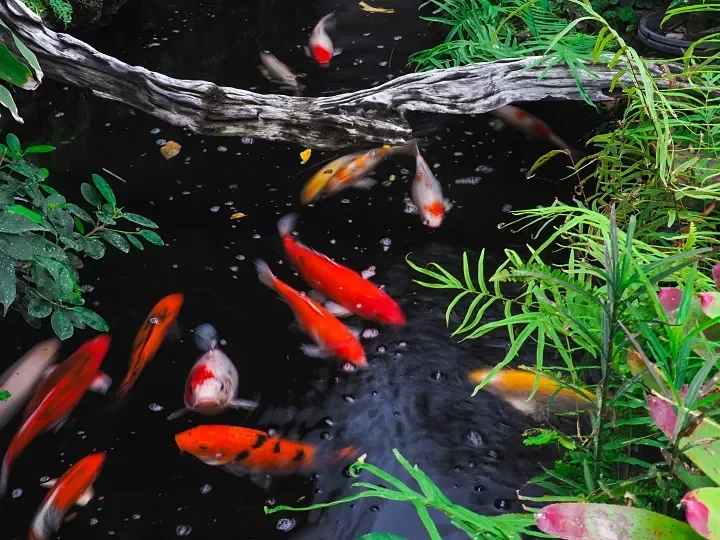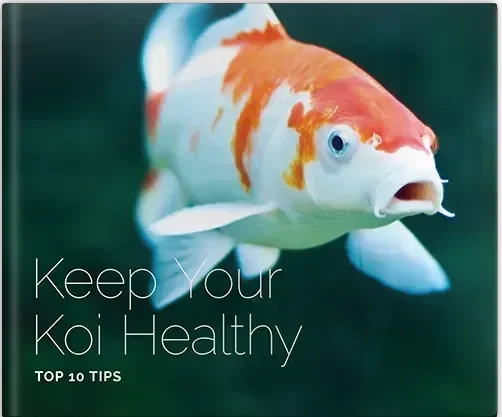How to Interpret Fish Body Language: Is It Good or Bad?
Did you know that fish possess subtle body language just like humans do? If you familiarize yourself with good body language in fish, you’ll be equipped to recognize bad fish body language. Once you recognize the bad behaviour, you’ll be able to diagnose and treat your fish before any illness or situation becomes too severe.
• Let’s first take a look at good body language in your pond fish:
• Cruising the upper levels of the pond looking for food
• A lot of pectoral fin movement, especially to examine the water’s surface
• Voracious appetite
• Constant cruising
• Staying with the group of fish and not isolating themselves
• Flexing their body to see around them
• Rooting in the gravel on the pond bottom
If your fish exhibit the above, normal behaviour, you can rest assured that they’re happy and healthy. But what about when you see other types of behaviour that you’ve not noticed before?

Some examples of bad fish body language includes:
• Loss of appetite
• Clamped fins
• Resting on the bottom of the pond
• Laying on the bottom of the pond
• Stiff swimming with fins clamped
• Piping (gasping) at the pond’s surface
• Less active or floating still in the water
• Scratching or flashing
When you see any of the above behaviours, there’s a basic series of thoughts you should have to help determine what’s wrong and what you can do to help your finned friends.
Loss of appetite
Your fish eat lethargically or not at all. When the fish lose their appetite, numerous possibilities loom but without any additional symptoms, you could suspect some deterioration in water quality. In particular, warm water with low oxygen, which you’ll typically see during the hottest summer months. In ponds that are more than four feet deep and without water movement in the deeper areas, the oxygen levels sag, which can result in suffering fish. In either situation, add an aerator to boost oxygen levels in the pond.
Fish may also lose their appetite if nitrogen is imbalanced. When the nitrate levels climb in established ponds, fish will lose their appetite. A quick water test will let you know if nitrate is to blame. If nitrate is ruled out, then it could be a parasite problem. You’ll also notice a loss in appetite when the pond water temperature falls below 68-degrees Fahrenheit.
Clamped fins
When fish hold their fins close to their body, it’s a symptom of illness. Poor water quality and parasites are the likely culprits. Fish with clamped fins look like a fish with only a tail because all the other fins are pulled in close to the body. The fish may just rest on the bottom of the pond with its fins clamped. An assessment of water quality is the place to start. If nothing is found, the fish likely has a parasite that needs to be addressed (see how to identify and treat fish parasites).
Resting on the bottom
A common sign of illness is when the fish rests on the bottom of the pond. The most common cause of this bad fish body language is high water temperatures, high nitrates, and low oxygen levels. Parasites could also be the cause. Test the water, and if nothing is found, you’ve probably got a parasite issue.
Laying on the bottom
This behavior is slightly different because the fish will lay on the bottom of the pond on its side. This is a sign of severe, life-threatening stress. Usually, very, very cold water is the cause of this bad body language. Water quality and overwhelming parasitism can also cause this.
Stiff swimming with clamped fins
Stiff swimming is a serious sign in fish and almost always points to poor water quality, but the most common cause is parasitism, which is then swinging into a full-blown bacterial infection. Start by testing the water, and if nothing is found, a biopsy can be conducted to confirm the presence of parasites. You can also closely check the gills of your fish for signs of bacterial infection.
Piping at the pond surface
When fish are gasping at the surface of the pond, it’s highly illustrative of two things. Either the pond water doesn’t have enough oxygen in it, or the fish can’t get that oxygen because its gills are being wrecked by something. Adding an aerator typically alleviates this problem but if it doesn’t, you likely have a parasite problem.
Less active or floating in water
Less activity isn’t necessarily a sign of illness, but you’ll want to keep some things in mind. Low oxygen levels can cause the fish to resist higher activity and foraging Did you know that fish possess subtle body language just like humans do? If you familiarize yourself with good body language in fish, you’ll be equipped to recognize bad fish body language. Once you recognize the bad behavior, you’ll be able to diagnose and treat your fish before any illness or situation becomes too severe.
Let’s first take a look at good body language in your pond fish:
• Cruising the upper levels of the pond looking for food
• A lot of pectoral fin movement, especially to examine the water’s surface
• Voracious appetite
• Constant cruising
• Staying with the group of fish and not isolating themselves
• Flexing their body to see around them
• Rooting in the gravel on the pond bottom
If your fish exhibit the above, normal behavior, you can rest assured that they’re happy and healthy. But what about when you see other types of behavior that you’ve not noticed before?

Some examples of bad fish body language includes:
Loss of appetite
• Clamped fins
• Resting on the bottom of the pond
• Laying on the bottom of the pond
• Stiff swimming with fins clamped
• Piping (gasping) at the pond’s surface
• Less active or floating still in the water
• Scratching or flashing
When you see any of the above behaviors, there’s a basic series of thoughts you should have to help determine what’s wrong and what you can do to help your finned friends.
Loss of appetite
Your fish eat lethargically or not at all. When the fish lose their appetite, numerous possibilities loom but without any additional symptoms, you could suspect some deterioration in water quality. In particular, warm water with low oxygen, which you’ll typically see during the hottest summer months. In ponds that are more than four feet deep and without water movement in the deeper areas, the oxygen levels sag, which can result in suffering fish. In either situation, add an aerator to boost oxygen levels in the pond.
Fish may also lose their appetite if nitrogen is imbalanced. When the nitrate levels climb in established ponds, fish will lose their appetite. A quick water test will let you know if nitrate is to blame. If nitrate is ruled out, then it could be a parasite problem. You’ll also notice a loss in appetite when the pond water temperature falls below 68-degrees Fahrenheit.
Clamped fins
When fish hold their fins close to their body, it’s a symptom of illness. Poor water quality and parasites are the likely culprits. Fish with clamped fins look like a fish with only a tail because all the other fins are pulled in close to the body. The fish may just rest on the bottom of the pond with its fins clamped. An assessment of water quality is the place to start. If nothing is found, the fish likely has a parasite that needs to be addressed (see how to identify and treat fish parasites).
Resting on the bottom
A common sign of illness is when the fish rests on the bottom of the pond. The most common cause of this bad fish body language is high water temperatures, high nitrates, and low oxygen levels. Parasites could also be the cause. Test the water, and if nothing is found, you’ve probably got a parasite issue.
Laying on the bottom
This behaviour is slightly different because the fish will lay on the bottom of the pond on its side. This is a sign of severe, life-threatening stress. Usually, very, very cold water is the cause of this bad body language. Water quality and overwhelming parasitism can also cause this.
Stiff swimming with clamped fins
Stiff swimming is a serious sign in fish and almost always points to poor water quality, but the most common cause is parasitism, which is then swinging into a full-blown bacterial infection. Start by testing the water, and if nothing is found, a biopsy can be conducted to confirm the presence of parasites. You can also closely check the gills of your fish for signs of bacterial infection.
Piping at the pond surface
When fish are gasping at the surface of the pond, it’s highly illustrative of two things. Either the pond water doesn’t have enough oxygen in it, or the fish can’t get that oxygen because its gills are being wrecked by something. Adding an aerator typically alleviates this problem but if it doesn’t, you likely have a parasite problem.
Less active or floating in water
Less activity isn’t necessarily a sign of illness, but you’ll want to keep some things in mind. Low oxygen levels can cause the fish to resist higher activity and foraging behaviours. This would be especially true if the listless, lifeless fish are the larger ones whose oxygen demand is higher. Warm water carries less oxygen and if the pond is warm and there’s minimal water turnover from a waterfall or aerator, this could be a contributor. Adding a pond aerator will remedy this problem within four to six hours. If the fish becomes actively engaged again, you’ve solved the problem. If not, suspect the presence of a parasite.
Flashing behaviour
Flashing, or scratching, is bad body language when it’s common among your fish. It’s not uncommon to see a fish flash or scratch on the pond bottom of other submerged ornamentation. This isn’t considered a problem. However, if you see many fish scratching or flashing every hour, that would be bad body language and considered a problem. Flashing can be caused by several things, but your main suspects are the pH level of the pond, or a parasite.
Once you become familiar with good and bad body language in your pond fish, you’ll be better equipped to remedy any negative situation and provide them with a healthy, happy home.
Learn more about caring for koi and pond fish with our free eBook, Keep Your Koi Healthy: Top 10 Tips:

This would be especially true if the listless, lifeless fish are the larger ones whose oxygen demand is higher. Warm water carries less oxygen and if the pond is warm and there’s minimal water turnover from a waterfall or aerator, this could be a contributor. Adding a pond aerator will remedy this problem within four to six hours. If the fish becomes actively engaged again, you’ve solved the problem. If not, suspect the presence of a parasite.
Flashing behaviour
Flashing, or scratching, is bad body language when it’s common among your fish. It’s not uncommon to see a fish flash or scratch on the pond bottom of other submerged ornamentation. This isn’t considered a problem. However, if you see many fish scratching or flashing every hour, that would be bad body language and considered a problem. Flashing can be caused by several things, but your main suspects are the pH level of the pond, or a parasite.
Once you become familiar with good and bad body language in your pond fish, you’ll be better equipped to remedy any negative situation and provide them with a healthy, happy home.
for more information contact us here.
Contact us
